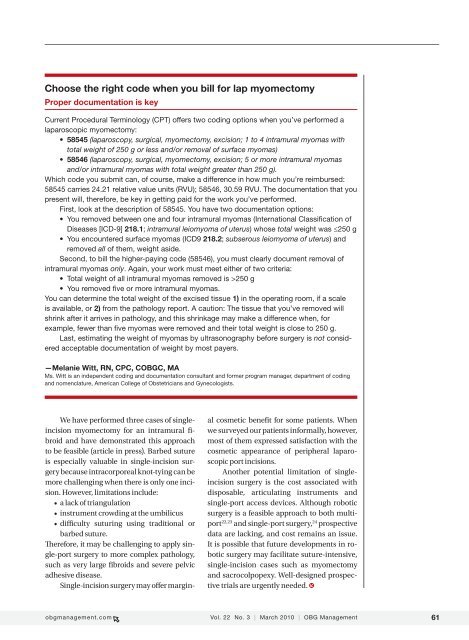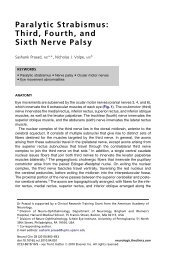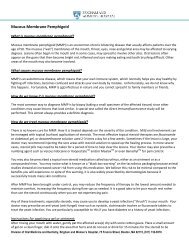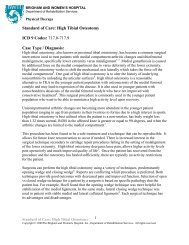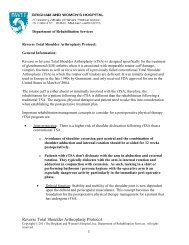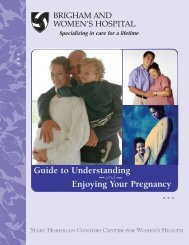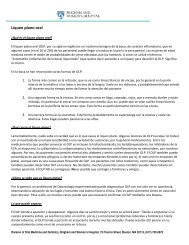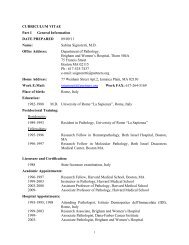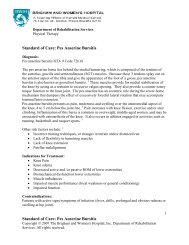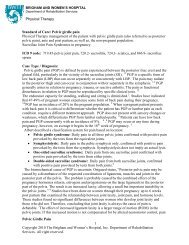Laparoscopic Myomectomy - Brigham and Women's Hospital
Laparoscopic Myomectomy - Brigham and Women's Hospital
Laparoscopic Myomectomy - Brigham and Women's Hospital
You also want an ePaper? Increase the reach of your titles
YUMPU automatically turns print PDFs into web optimized ePapers that Google loves.
Choose the right code when you bill for lap myomectomy<br />
Proper documentation is key<br />
Current Procedural Terminology (CPT) offers two coding options when you’ve performed a<br />
laparoscopic myomectomy:<br />
• 58545 (laparoscopy, surgical, myomectomy, excision; 1 to 4 intramural myomas with<br />
total weight of 250 g or less <strong>and</strong>/or removal of surface myomas)<br />
• 58546 (laparoscopy, surgical, myomectomy, excision; 5 or more intramural myomas<br />
<strong>and</strong>/or intramural myomas with total weight greater than 250 g).<br />
Which code you submit can, of course, make a difference in how much you’re reimbursed:<br />
58545 carries 24.21 relative value units (RVU); 58546, 30.59 RVU. The documentation that you<br />
present will, therefore, be key in getting paid for the work you’ve performed.<br />
First, look at the description of 58545. You have two documentation options:<br />
• You removed between one <strong>and</strong> four intramural myomas (International Classification of<br />
Diseases [ICD-9] 218.1; intramural leiomyoma of uterus) whose total weight was ≤250 g<br />
• You encountered surface myomas (ICD9 218.2; subserous leiomyoma of uterus) <strong>and</strong><br />
removed all of them, weight aside.<br />
Second, to bill the higher-paying code (58546), you must clearly document removal of<br />
intramural myomas only. Again, your work must meet either of two criteria:<br />
• Total weight of all intramural myomas removed is >250 g<br />
• You removed five or more intramural myomas.<br />
You can determine the total weight of the excised tissue 1) in the operating room, if a scale<br />
is available, or 2) from the pathology report. A caution: The tissue that you’ve removed will<br />
shrink after it arrives in pathology, <strong>and</strong> this shrinkage may make a difference when, for<br />
example, fewer than five myomas were removed <strong>and</strong> their total weight is close to 250 g.<br />
Last, estimating the weight of myomas by ultrasonography before surgery is not considered<br />
acceptable documentation of weight by most payers.<br />
—Melanie Witt, RN, CPC, COBGC, MA<br />
Ms. Witt is an independent coding <strong>and</strong> documentation consultant <strong>and</strong> former program manager, department of coding<br />
<strong>and</strong> nomenclature, American College of Obstetricians <strong>and</strong> Gynecologists.<br />
We have performed three cases of singleincision<br />
myomectomy for an intramural fibroid<br />
<strong>and</strong> have demonstrated this approach<br />
to be feasible (article in press). Barbed suture<br />
is especially valuable in single-incision surgery<br />
because intracorporeal knot-tying can be<br />
more challenging when there is only one incision.<br />
However, limitations include:<br />
• a lack of triangulation<br />
• instrument crowding at the umbilicus<br />
• difficulty suturing using traditional or<br />
barbed suture.<br />
Therefore, it may be challenging to apply single-port<br />
surgery to more complex pathology,<br />
such as very large fibroids <strong>and</strong> severe pelvic<br />
adhesive disease.<br />
Single-incision surgery may offer margin-<br />
al cosmetic benefit for some patients. When<br />
we surveyed our patients informally, however,<br />
most of them expressed satisfaction with the<br />
cosmetic appearance of peripheral laparoscopic<br />
port incisions.<br />
Another potential limitation of singleincision<br />
surgery is the cost associated with<br />
disposable, articulating instruments <strong>and</strong><br />
single-port access devices. Although robotic<br />
surgery is a feasible approach to both multiport<br />
22,23 <strong>and</strong> single-port surgery, 24 prospective<br />
data are lacking, <strong>and</strong> cost remains an issue.<br />
It is possible that future developments in robotic<br />
surgery may facilitate suture-intensive,<br />
single-incision cases such as myomectomy<br />
<strong>and</strong> sacrocolpopexy. Well-designed prospective<br />
trials are urgently needed.<br />
obgmanagement.com Vol. 22 No. 3 | March 2010 | OBG Management 61


